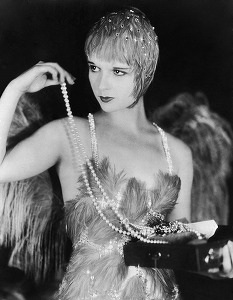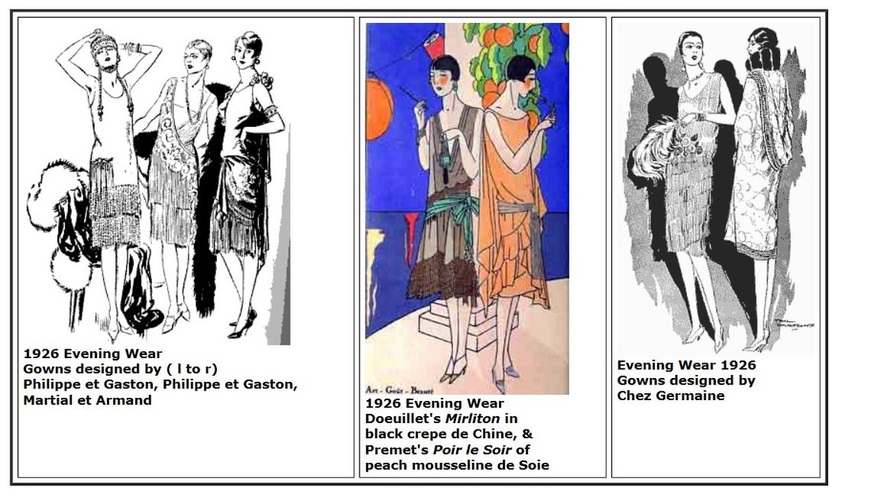Flapper Fashion

The 1920s were times of great change. Coming out of the horror of the First World War, society exploded in a million different directions. The Twenties saw women voting, the Harlem Rennaisance, prohibition, and an incredible burst of affluence for the middle class. Automobiles and electric appliances made people's lives easier and gave them more leisure time.
The incredible, rapid social changes that struck the country are clearly illustrated by women's fashions of the decade.
Early Twenties
The salient features of women's clothing in the 20's are short skirts and dropped waistlines. The silhouettes of the earlier part of the decade are long and cylindrical, with the skirt falling 7" to 10" below the knee.
Despite the relatively simple silhouette, the wide variety of detail was astonishing. Even inexpensive, ready-made clothing from catalog and chain stores such as Sears portrayed an imaginative range of cuts and trims.
The long straight style had a great many variations, one extremely popular fashion was the Basque dress or Robe de Style. This dress style is best known from the beautiful creations of Jeanne Lanvin. It is a sort of compromise between the straight twenties silhouette and the old fashioned belled-skirt.
It featured a tubular bodice that draped straight down to a dropped waist, then a full skirt (not bias cut, but with gathers at the waist) ending at mid-calf or ankle. These were very popular for afternoon and evening wear.
The incredible, rapid social changes that struck the country are clearly illustrated by women's fashions of the decade.
Early Twenties
The salient features of women's clothing in the 20's are short skirts and dropped waistlines. The silhouettes of the earlier part of the decade are long and cylindrical, with the skirt falling 7" to 10" below the knee.
Despite the relatively simple silhouette, the wide variety of detail was astonishing. Even inexpensive, ready-made clothing from catalog and chain stores such as Sears portrayed an imaginative range of cuts and trims.
The long straight style had a great many variations, one extremely popular fashion was the Basque dress or Robe de Style. This dress style is best known from the beautiful creations of Jeanne Lanvin. It is a sort of compromise between the straight twenties silhouette and the old fashioned belled-skirt.
It featured a tubular bodice that draped straight down to a dropped waist, then a full skirt (not bias cut, but with gathers at the waist) ending at mid-calf or ankle. These were very popular for afternoon and evening wear.
Mid Twenties
The silhouette of the early twenties was still rooted in the shirtwaist and skirt mode of the teens. It was in high fashion that the long straight silhouette started to get a toe-hold. As the decade continued, the long straight shape moved to day time wear. Then evening wear became straighter and shorter, after which daytime wear copied it.
It was in evening wear that the innovations of twenties style first appeared. By 1926, women who grew up in a world that barely acknowledged knees were very nearly wearing their dresses above them. This is when the modern fashion concept of the flapper first appeared. The name 'flapper' - meaning a young modern woman who went out on dates without a chaperone, wore fashionable clothes, wore make-up, and possibly had a job - had already made appearances as early as 1919. The 'bob' haircut had been introduced in New York by the society dancer Irene Castle in 1914, she had acquired it on a European tour where she'd seen fashionable Parisians wearing it.
The silhouette of the early twenties was still rooted in the shirtwaist and skirt mode of the teens. It was in high fashion that the long straight silhouette started to get a toe-hold. As the decade continued, the long straight shape moved to day time wear. Then evening wear became straighter and shorter, after which daytime wear copied it.
It was in evening wear that the innovations of twenties style first appeared. By 1926, women who grew up in a world that barely acknowledged knees were very nearly wearing their dresses above them. This is when the modern fashion concept of the flapper first appeared. The name 'flapper' - meaning a young modern woman who went out on dates without a chaperone, wore fashionable clothes, wore make-up, and possibly had a job - had already made appearances as early as 1919. The 'bob' haircut had been introduced in New York by the society dancer Irene Castle in 1914, she had acquired it on a European tour where she'd seen fashionable Parisians wearing it.
Late Twenties
As the decade reached its end, fashion started to revert to a longer silhouette, and waist lines began to make a tentative reappearance. The fabrics and cut clung more closely to the body, foreshadowing the bias cuts of the 30s. As a sort of compromise between the old shorter skirt and the newer longer skirt, there was a brief period (c.1928) when evening clothes had both. Again it was evening wear that led the way, while daywear still clung to the flapper fashion ideal.
The fashions we regard as 'the Flapper look' only lasted about 3 years, from 1925 to 1928. By 1928 high fashion had drifted onward, but the look of the Flapper lives on in popular consciousness.
As the decade reached its end, fashion started to revert to a longer silhouette, and waist lines began to make a tentative reappearance. The fabrics and cut clung more closely to the body, foreshadowing the bias cuts of the 30s. As a sort of compromise between the old shorter skirt and the newer longer skirt, there was a brief period (c.1928) when evening clothes had both. Again it was evening wear that led the way, while daywear still clung to the flapper fashion ideal.
The fashions we regard as 'the Flapper look' only lasted about 3 years, from 1925 to 1928. By 1928 high fashion had drifted onward, but the look of the Flapper lives on in popular consciousness.



